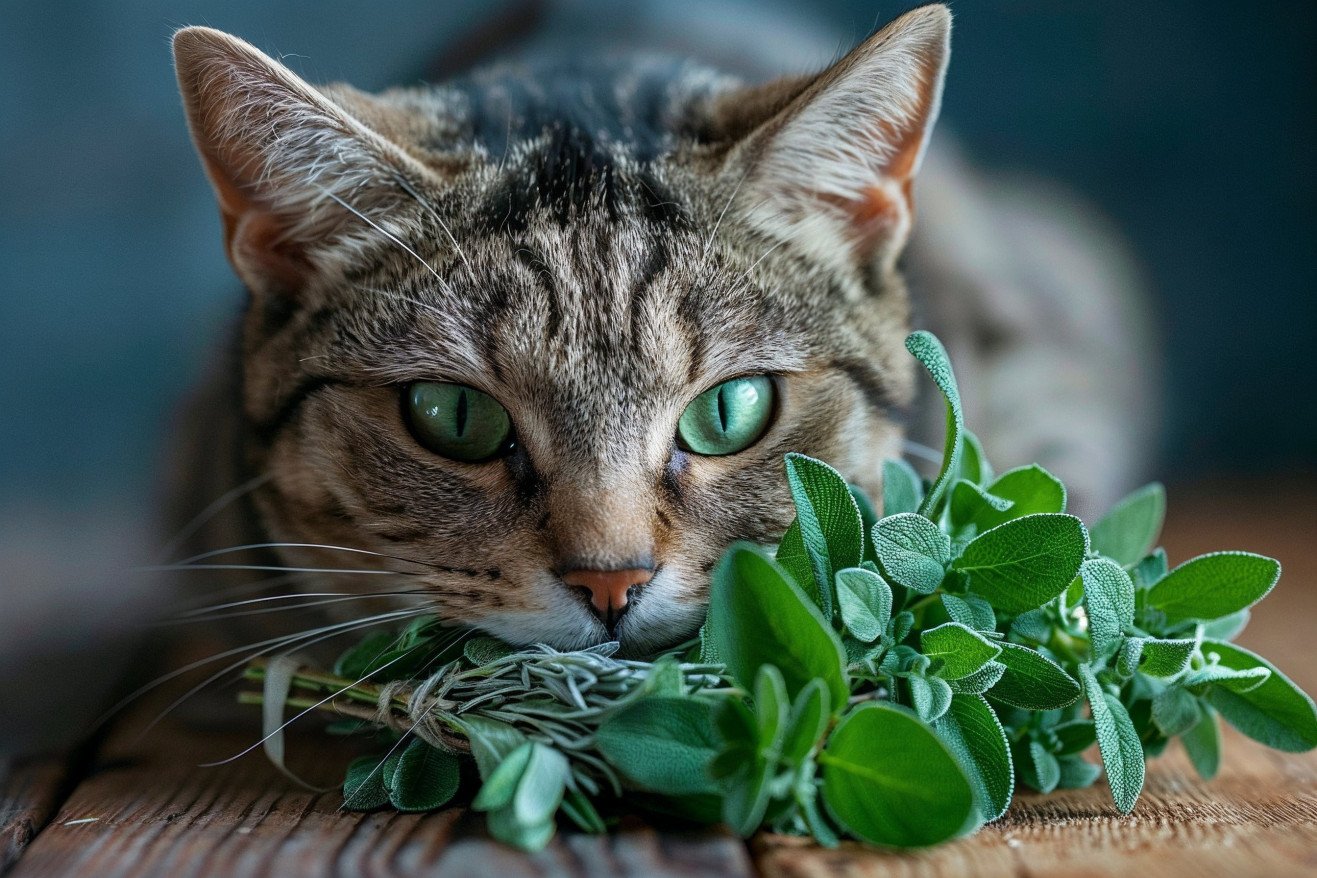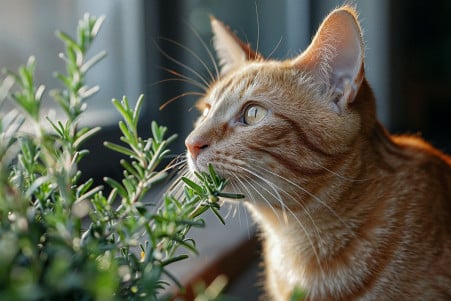Can Cats Eat Sage? What Vets Say
5 June 2024 • Updated 4 June 2024

Is sage safe for cats, or can this popular culinary herb be harmful to your pet? While sage is not toxic to cats in small amounts, larger doses can cause stomach upset, vomiting, or diarrhea due to the volatile oils and tannins it contains. As with many things in life, the key is to use sage in moderation when giving it to your cat.
In addition to the anecdotal information about how sage may affect cats, we'll explore the scientific evidence from the fields of veterinary medicine, botany, and animal nutrition to get a more well-rounded view. This will include what the research says about the chemical makeup of sage, any known dangers to cats, and how much sage experts believe can be safely added to a cat's diet. By the time we're done, you'll know whether or not it's a good idea to add sage to your cat's meals.
Is sage safe for cats?
Potential Risks: Exploring Sage Toxicity in Cats
While sage is a common culinary herb, it contains compounds such as thujone, camphor, and volatile oils that are toxic to cats if consumed in large quantities. Signs of sage toxicity in cats can include vomiting, diarrhea, central nervous system depression, seizures, coma, and even liver damage.
There is no established safe dose of sage for cats, and in general, most experts agree that the risks of feeding sage to cats outweigh the potential benefits. This is because cats are obligate carnivores and don’t have the enzymes necessary to break down certain plant-based compounds, making them more susceptible to toxicity from herbs like sage.
If a cat has consumed a toxic amount of sage, it’s important to seek immediate veterinary care to avoid long-term neurological or organ damage. Treatment may include vomiting induction, activated charcoal administration, and supportive care such as IV fluids, anti-nausea medications, and pain management to address the toxic effects. While some sage plants like Sage Bush may be less toxic, cats’ individual reactions to plant compounds can vary, so it’s best to err on the side of caution. Any potential benefits of sage should be carefully considered in light of these risks.
Potential Benefits: Sage's Medicinal Properties for Cats
Although the dangers of cats eating sage are well-documented, there are some potential benefits to using sage in cats in small amounts and under the guidance of a veterinarian. Sage is an herb with antibacterial and antifungal properties, which can help to prevent infections and support your pet's overall health. Some alternative veterinarians may suggest using sage in small amounts to treat certain conditions, but this research is also limited, and in most cases, the dangers of using sage in cats outweigh the potential benefits.
Sage can be planted as an ornamental herb in a cat-safe garden, but it's important to take steps to ensure that your cat doesn't accidentally eat it. As Season Herbs explains, sage is a lovely, decorative herb, and you can grow it if you have cats, so feel free to keep this one on the windowsill or anywhere else you like. That said, more research is necessary to determine the full benefits and safe applications of sage for cats, as the information that currently exists is both limited and based on personal experience.
Safe Amounts and How to Feed Cats Sage
Although sage can be poisonous to cats in large amounts, small amounts can be safe, but it’s important to use it in moderation. Hepper explains, cats are obligate carnivores, requiring a meat-based diet for longevity and health. Some plants are safe for cats in moderation, and sage is one of them. That said, it’s best to avoid giving sage to cats as a treat or in large amounts since the amount of sage that’s safe for cats isn’t known.
Fresh or dried sage can be used in small amounts as a seasoning for cats’ food, but their consumption should be monitored for any signs of problems. Catster notes that eating too much sage can cause gastrointestinal upset like vomiting and diarrhea in cats. Cats should never be allowed to eat sage plants or leaves directly because they may consume too much.
It’s best to avoid using sage essential oils around cats because they can be very strong and even poisonous to them. As the ASPCA explains, essential oils can be harmful to cats if ingested or absorbed through the skin.
Safety and Sustainability for Cats
Smudging with sage should be done carefully and with good ventilation when cats are present, as the smoke can cause respiratory distress, especially in cats with pre-existing conditions or allergies. Per PetFirst, burning sage around cats doesn't inflict any harm except a mild irritation to their eyes, nose, and upper respiratory tract. That said, cats with a respiratory condition such as asthma or bronchitis can show signs of distress and discomfort when exposed to smudging.
Sage essential oils should be avoided in homes with cats due to their high concentration and potential for toxicity if ingested or absorbed through the skin. Per the NAHA Certified Aromatherapist, cats do not have the ability to metabolize and eliminate certain compounds in essential oils. Cats lack an essential enzyme in their liver and as such have difficulty metabolizing and eliminating certain toxins in essential oils. This can lead to a buildup of toxins in their systems. Oils with a high ketone content, like sage, are especially risky for cats.
If you're growing sage, it's important to take steps to keep cats from eating the plants, such as putting up barriers, keeping them out of reach, or offering cat-friendly alternatives. Per The Pet Beastro, sage is best used as a tea or tincture. Some varieties like Autumn Sage and Lyre-Leaf Sage are safer for cats, but it's still best to be cautious and keep an eye on your cat if you have sage plants. Make sure everyone in your household is aware of the risks and how to safely handle sage around cats to avoid accidental exposure or ingestion.
Safe Gardening: How to Grow Sage If You Have Cats
If you want to grow sage in a home with cats, it's important to take steps to avoid accidental consumption or contact. The Spruce explains, just as there are flowers that attract cats, there are others that drive them away. Flowers with aromatic foliage, like Russian sage, lavender, citronella, and geraniums don't appeal to cats. You can also keep cats away from sage by planting it in a fenced-off area or in a raised bed.
In addition, you can plant other flowers that cats find less appealing or provide cat-friendly alternatives like catnip or basil to keep cats away from your sage. Greg suggests, cat-friendly alternatives to Autumn Sage include basil, thyme, and catnip, which are non-toxic to cats. In addition to these measures, responsible gardening with cats involves strategic planting, regular supervision, and making sure everyone in your household is aware of the potential dangers.
While some sage species, including Autumn Sage and Lyre-Leaf Sage, are less toxic to cats, it's still important to be careful and keep an eye on your pets. According to Greg, Autumn Sage lacks the toxic compounds found in many other plants dangerous to cats and Lyre-Leaf Sage is not toxic to cats. Still, it's important to practice responsible gardening with cats to make sure your pets stay safe.
Conclusion: How to Safely Integrate Sage and Cats
Although sage is generally safe for cats, if they consume too much of it, they can experience health problems due to the thujone, camphor, and volatile oils in the plant. The safe dosage of sage for cats is unknown, and the risks of feeding it to them often outweigh the benefits, according to experts.
It’s important to use sage with caution and to monitor your cat closely if you decide to give it to them or grow it in your home. It’s also best to avoid sage essential oils. To keep your cat safe, you can take steps like fencing off or raising sage plants and providing cat-friendly plants.
Finally, make sure to talk to your vet about your cat’s diet and to make sure everyone in your home knows how to safely interact with cats and sage.


